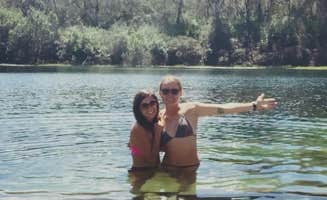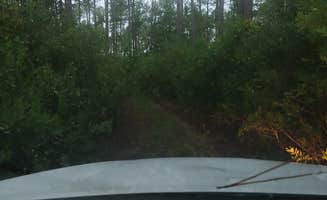Dispersed camping near Casselberry, Florida extends beyond the main Ocala National Forest area into surrounding public lands with varied terrain. Summer camping requires preparation for Florida's characteristic high humidity and temperatures often exceeding 90°F, while winter months offer milder temperatures in the 50-70°F range. Weather patterns shift seasonally with summer afternoon thunderstorms common from June through September, influencing accessibility to remote sites.
What to do
Kayaking access points: At Trout Lake Primitive Sites, campers can launch kayaks directly from shoreline campsites. The lake supports both fishing and recreational paddling with relatively calm waters suitable for beginners. "Very narrow trails but really easy access, you will leave with some new pinstripes," notes reviewer Joe P., referencing the tight tree clearance on access roads.
Swimming opportunities: Natural swimming areas exist at some dispersed sites, particularly during warmer months. Freak Creek Dispersed Camping features "a nice creek area where you can swim and or fish if you have the right equipment to get back there," according to reviewer Hilary G. Water levels fluctuate seasonally, with deeper swimming holes typically available spring through fall.
Stargazing locations: Clear night skies reward campers at riverside locations away from light pollution. The St. Johns River area provides optimal viewing conditions on cloudless nights. "Right next to the river and the trees open up so you get a great view of the stars," reports Mike D. about his experience at the riverside camping area.
What campers like
Seclusion factor: Campers consistently value the privacy offered by difficult-to-access sites. "It's super secluded and quiet. Depending when you stay there's at times people who show up to party and then leave," explains Adamm A. about Freak Creek Dispersed Camping. Most sites feature natural buffers of vegetation creating private camping spots.
Natural features: Unique geological formations attract visitors seeking distinctive Florida landscapes. "Most beautiful place to stumble upon. You may need ATV or creative backpacking to get there now," states Destiny R. about Blue Sink, noting access challenges after forestry operations affected roads.
Wildlife viewing: The forest ecosystem supports diverse wildlife observation opportunities. Campers report various animal sightings including deer, wild turkeys, and occasionally larger predators. As one camper noted, "I talked to another person that use to go out there and said she has seen a panther. I've yet to see anything."
What you should know
Vehicle requirements: Four-wheel drive vehicles with adequate clearance are essential for most sites. Access roads frequently present challenges including sand, water crossings, and tight clearances. At Trout Lake Primitive Sites, "Main road entry is packed dirt; smaller access road to sites is two-track about 1/4 mile through woods — very narrow tree clearance. 4WD recommended. Just barely scraped a FWD Promaster through the trees."
Communication limitations: Cell service ranges from unreliable to nonexistent at most locations. One camper reports "Poor cell service even with booster. Plan on returning after antenna upgrade." Emergency communication devices like satellite messengers are recommended for safety.
Cleanliness concerns: Site conditions vary widely depending on previous visitors. "Not the cleanest but passable," notes one camper about primitive spots. The pack-in, pack-out principle applies to all free camping near Casselberry, as no trash services exist.
Tips for camping with families
Safety planning: Families should establish clear emergency protocols before arrival due to limited communication options. Keep children within sight due to potential wildlife encounters and natural hazards like sinkholes or deep water. Bring comprehensive first aid supplies as medical help can be 30+ minutes away from remote camping locations.
Water supply: No potable water exists at dispersed sites near Casselberry. Families should calculate 1-2 gallons per person per day depending on activities and weather conditions. Lake Mary Tent Camping area requires complete water self-sufficiency with no natural filtration sources nearby.
Bug protection: Florida's subtropical climate supports significant mosquito and tick populations, especially during warmer months. Physical barriers like screened tents provide necessary protection, particularly at dusk and dawn when insect activity peaks. Bring specialized repellents suitable for children's sensitive skin.
Tips from RVers
Size restrictions: Most dispersed camping areas cannot accommodate standard RVs due to access limitations. "I would not attempt bringing a camper unless it's really small," advises one camper about Freak Creek. Vehicles longer than 20 feet generally cannot navigate the narrow access roads to primitive sites.
Recovery equipment: Sand and seasonal flooding create challenging conditions even for properly equipped vehicles. Carry recovery boards, traction aids, and a good-quality tow strap. According to one visitor at South Tower Hunt Camp, the sandy access roads can strand unprepared vehicles, particularly after rain events.
Leveling challenges: Natural terrain at dispersed sites rarely provides level parking. Bring substantial leveling blocks and stabilizers to establish safe camping platforms. Scout locations carefully before committing to a spot, as sandy areas can shift under vehicle weight.



